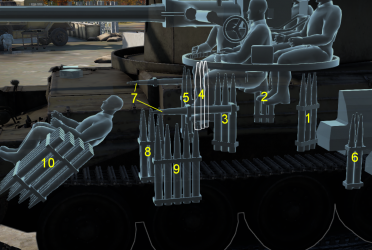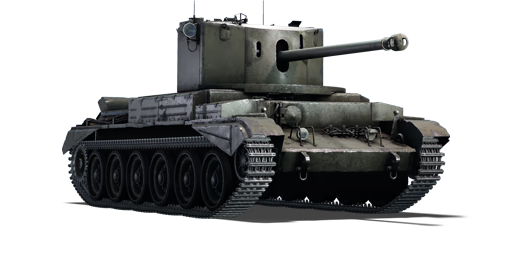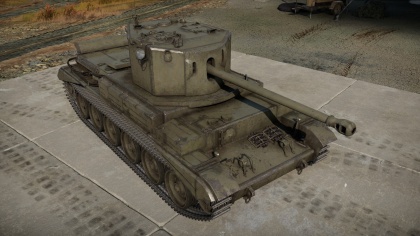Difference between revisions of "Challenger"
(Fixed up page) |
m (Corrected Links) |
||
| Line 223: | Line 223: | ||
=== Machine guns === | === Machine guns === | ||
<!--''Offensive and anti-aircraft machine guns not only allow you to fight some aircraft, but also are effective against lightly armoured vehicles. Evaluate machine guns and give recommendations on its use.''--> | <!--''Offensive and anti-aircraft machine guns not only allow you to fight some aircraft, but also are effective against lightly armoured vehicles. Evaluate machine guns and give recommendations on its use.''--> | ||
| − | {{main| | + | {{main|M1919A4 (7.62 mm)}} |
{| class="wikitable" style="text-align:center" | {| class="wikitable" style="text-align:center" | ||
|- | |- | ||
| − | ! colspan="7" | [[ | + | ! colspan="7" | [[M1919A4(7.62 mm)|7.62 mm M1919A4]] |
|- | |- | ||
! colspan="7" | ''Coaxial mount'' | ! colspan="7" | ''Coaxial mount'' | ||
Revision as of 23:32, 22 February 2019
Contents
Description
The A30 Challenger is a Rank III British medium tank with a battle rating of 5.3 (AB/RB/SB). It was introduced in Update 1.55 "Royal Armour" alongside the rest of the British Ground Forces Tree. Taking the outdated Cromwell chassis, extending it and adding a new turret, it gave life to this improved variant with the much powerful 17-pounder anti-tank gun.
General info
Survivability and armour
Armour type:
- Rolled homogeneous armour
| Tank Armour Table | |||||
| Armour | Front | Sides | Rear | Roof | |
|---|---|---|---|---|---|
| Hull | 63.5 mm (1°) Front plate 30 mm (73°) Front glacis 57.15 mm (19-35°) Joint plate 25 mm (65°) Lower glacis |
29-50.8 mm Top hull 14 + 14 mm Lower Hull |
51 mm Turret base 38 mm Top hull 38 mm (19°), 20 mm (57°) Lower Hull |
20 mm Front 14 mm Engine deck | |
| Turret | 63-102 mm (0-1°) Turret front 102 mm (4-12°) Gun mantlet |
40 mm | 40 mm (1°) | 20 mm | |
Notes:
- Suspension wheels are 15 mm thick, suspension bars are 10 mm thick, while tracks are 20 mm thick.
- 5 mm RHA plates between the engine compartment and crew, as well as separating driver from turret and ammunition.
- Lower side hulls are spaced with the suspension springs lined up in between.
- A 25 mm RHA bar line up in front of the turret to protect the turret ring.
Mobility
| Mobility characteristic | ||
|---|---|---|
| Weight (tons) | Add-on Armor weight (tons) |
Max speed (km/h) |
| 31.5 | N/A | 58 (AB) |
| 52 (RB/SB) | ||
| Engine power (horsepower) | ||
| Mode | Stock | Upgraded |
| Arcade | 930 | 1,145 |
| Realistic/Simulator | 531 | 600 |
| Power-to-weight ratio (hp/ton) | ||
| Mode | Stock | Upgraded |
| Arcade | 29.52 | 36.35 |
| Realistic/Simulator | 16.86 | 19.05 |
Armaments
Main armament
| 76 mm OQF 17-pounder | |||||
|---|---|---|---|---|---|
| Capacity | Vertical guidance |
Horizontal guidance |
Stabilizer | ||
| 48 | -10°/+20° | ±180° | N/A | ||
| Turret rotation speed (°/s) | |||||
| Mode | Stock | Upgraded | Prior + Full crew | Prior + Expert qualif. | Prior + Ace qualif. |
| Arcade | 8.30 | 11.50 | _.__ | _.__ | _.__ |
| Realistic | 8.30 | 9.80 | _.__ | _.__ | _.__ |
| Reloading rate (seconds) | |||||
| Stock | Prior + Full crew | Prior + Expert qualif. | Prior + Ace qualif. | ||
| 6.70 | _.__ | _.__ | _.__ | ||
Ammunition
| Penetration statistics | |||||||
|---|---|---|---|---|---|---|---|
| Ammunition | Type of warhead |
Penetration in mm @ 90° | |||||
| 10m | 100m | 500m | 1000m | 1500m | 2000m | ||
| Shot Mk.6 | AP | 160 | 157 | 133 | 112 | 96 | 86 |
| Shell Mk.1 | HE | 9 | 9 | 9 | 9 | 9 | 9 |
| Shot Mk.4 | APC | 165 | 160 | 138 | 108 | 94 | 81 |
| Shot Mk.8 | APCBC | 171 | 168 | 156 | 143 | 130 | 120 |
| Shot SV Mk.1 | APDS | 228 | 226 | 207 | 189 | 159 | 134 |
| Shell details | ||||||||||
|---|---|---|---|---|---|---|---|---|---|---|
| Ammunition | Type of warhead |
Velocity in m/s |
Projectile Mass in kg |
Fuse delay
in m: |
Fuse sensitivity
in mm: |
Explosive Mass in g (TNT equivalent): |
Normalization At 30° from horizontal: |
Ricochet: | ||
| 0% | 50% | 100% | ||||||||
| Shot Mk.6 | AP | 883 | 7.7 | N/A | N/A | N/A | -1° | 47° | 60° | 65° |
| Shell Mk.1 | HE | 883 | 7.0 | 0.4 | 0.5 | 883 | +0° | 79° | 80° | 81° |
| Shot Mk.4 | APC | 883 | 7.7 | N/A | N/A | N/A | -1° | 48° | 63° | 71° |
| Shot Mk.8 | APCBC | 883 | 7.7 | N/A | N/A | N/A | +4° | 48° | 63° | 71° |
| Shot SV Mk.1 | APDS | 1203 | 1.7 | N/A | N/A | N/A | +1.5° | 75° | 78° | 80° |
| Smoke characteristic | ||||||
|---|---|---|---|---|---|---|
| Ammunition | Velocity in m/s |
Projectile Mass in kg |
Screen radius in m |
Screen time in s |
Screen hold time in s: |
Explosive Mass in g (TNT equivalent): |
| 17pdr Shell SS Mk.1 | 754 | 8.4 | 13 | 5 | 20 | 50 |
| Shell usage | ||
|---|---|---|
| Round | Shell composition | Combat usage |
| Shell Mk.1 | HE - High Explosive (HE) | It is ideal for destroying SPAA and lightly armoured tanks, but useless against anything else. |
| Shot Mk.4 | APC - Armor Piercing Cap | Cap for better grip against sloped armour. |
| Shot Mk.6 | AP - Armour Piercing | Standard penetrating round, use until unlocking better rounds. |
| Shot Mk.8 | APCBC - Armour Piercing Capped Ballistic Cap | Like Shot Mk.4 but with a ballistic cap for improved flight path, as well as better penetration. |
| Shot SV Mk.1 | APDS - Armour Piercing Discarding Sabot | Highest armour penetration of any shot, but has worse spalling effect. |
Ammo racks

| Full ammo |
1st rack empty |
2nd rack empty |
3rd rack empty |
Visual discrepancy |
|---|---|---|---|---|
| 48 | 37 (+11) | 25 (+23) | 1 (+47) | Yes |
Turret empty: 25 (+23)
Machine guns
| 7.62 mm M1919A4 | ||||||
|---|---|---|---|---|---|---|
| Coaxial mount | ||||||
| Capacity (Belt capacity) | Fire rate (shots/minute) |
Vertical guidance |
Horizontal guidance | |||
| 3,750 (250) | 500 | N/A | N/A | |||
Usage in the battles
This tank has a high penetration gun (with APDS), great maneuverability, and good speed. However, it has extremely weak armour, terrible reverse, and quite a high profile. As such it requires some skill to use. It excels as a sniper or an ambushing tank destroyer, waiting for the enemy to come into its sights and firing from a point of advantage. It is also a good flanker due to its speed and maneuverability, getting around the enemy and hitting them from the side or back.
Do not attempt to brawl or use this vehicle as a front line tank. The Challenger cannot afford to take even a single hit from enemy tanks, and it will be up against German 88 mm and Russian 85/122 mm guns which will easily take it out in one shot. The poor reverse speed also makes hit and run tactics a bad choice.
When in its stock form, this tank will be quite frustrating to play. The stock AP round bounces often and does very little damage, it is also quite hard to aim at range. The first aim upon getting this tank should be to unlock APDS as soon as possible. With this round, the Challenger can easily penetrate most of the tanks that it faces. Hitting ammo racks often equals a detonation and it performs well at long range.
Pros and cons
Pros:
- Armed with the 17-pounder with APDS rounds available.
- The Challenger has the fastest reload speed from all tanks armed with the 17-pounder.
- Able to deal a lot of damage in a very short amount of time.
- Fast tank that is capable of reaching 50km/h on even ground.
- Fast turret traverse.
- Wide gun depression and elevation.
- Plays similarly to the Comet I and Avenger, albeit with a higher profile and less armour on the turret.
- Turret armour is still about 102 mm thick in certain areas.
- Ammo is stored in a strategic location, lowering the risk of ammo detonation.
- Very low risk of fire due to rear mounted transmission and fuel tanks.
Cons:
- Paper thin hull armour (glass cannon).
- No explosive filler in any AP shells.
- APDS shot causes only punctual damage (aim carefully).
- Turret is very tall compared to hull profile, making it hard to hide behind obstacles.
- Suffers from an awful reverse speed.
- Four man in the turret, an APHE shot will disable the tank for good.
- The Challenger requires a very high skill cap to perform adequately.
History
Development
The development of the Cromwell tank due to the implementation of the Rolls-Royce Meteor engine helped Roy Robotham from Rolls to become the Minstry of Supply on the Tank Board, despite his lack of experience around the development of tanks. With the Cromwell in service with the British military, attempts were made to upgrade the armament on the tank from its 6-pounder and 75 mm gun. The first attempt was by Vickers with a "high-velocity" 75 mm gun, but the Cromwell turret ring proved too small for the adaption. While these attempts were made to upgun the Cromwell, improved tanks to replace the Cromwell was underway as the Comet and the Centurion tank. The General Staff specification for a 17-pounder armed cruiser tank was A29, but this was changed to A30 for any 17-pounder tank. The first order for such a tank came in 1942 to the Birmingham Railway Carriage & Wagon Company to build the 17-pounder tank from the components of the A27M Cromwell tank. While responsibility of the turret and gun mounting went to Stothert & Pitt, Birmingham was responsible for modifying the Cromwell hull for the new turret.
The resulting tank from the design team was completed in 1942. Compared to the Cromwell, the hull machine gun was removed for more stowage space for the longer 17-pounder ammunition. However, the stowage location and ammo size facilitated the need for two loaders in the tank to keep the firing rate stable. A larger turret was needed for this requirement, the larger turret thus caused the Cromwell hull to be lengthened with another road wheel on the suspension, but the track width was not modified to fit this so the tank's mobility was reduced. The total armour is reduced to save on weight, especially the turret area, which gave the crew inside the turret a sense of vulnerability. The turret ring of the turret was unprotected and was thus given a jacking feature to clear any jams that forms from combat situations.
The tank, named the A30 Challenger, was tested at Lulworth and was criticized for having a slow firing rate and thin armour, but its long range effectiveness against German tanks was satisfactory. An order for 200 Challengers was made in February 1943. The order was finished, but it was announced that no more were to be ordered on November the same year.
Combat usage
The Challenger was criticized and generally unpopular in its service, the crews complain that the tank throws its track, the armour was too thin, and the profile was too tall. The Challenger had no provisions for deep wading and was thus unable to participate during the D-day landings during Operation Overlord, thus the Challenger deployment was delayed until the artificial mulberry harbors and ports were captured before able to be delivered.
Though the Challenger saw some modifications to fix the track throwing issue, it was found that the equipping of the 17-pounder onto the American M4 Sherman tank into the Firefly was faster and easier than the production of the Challenger, thus production lines were stopped after the initial orders. Both tanks saw use in the same role in the British tank forces, accompanying the tank squadrons into enemy territory and firing at enemy armour from a long distance. The Challenger saw more use with Cromwell units due to interchangeability in parts. Some perks of the Challenger was its speed and agility compared to the Firefly, but the vehicle's initial bad reputation still struggled due to the low number produced in the war.
An attempt to improve on the Challenger was the A30 SP Avenger, which used a different open-topped turret to save weight on the tank design. However, due to priorities on the Comet tank in the Vauxhall Motors plant, they were not being built until 1945 and weren't used until after the war in Europe is over. 250 unit were built and formed part of the British Army of the Rhine stationed in Germany after the war.
The Challenger saw use with other Allied forces as well, with the 1st Czechoslovak Armoured Brigade using the tank during the assault on Dunkirk and the 1st Polish Armoured Division receiving them by mid-1945. After the war, Czechoslovakia wanted to buy 22 Challengers to equip its army, which it did until 1959.
Survivors
Two Challenger survive in intact condition today. One is at the Overloon War Museum in the Netherlands and the other is currently in storage at the Isle of Wight Military Museum to be restored, when it will then be displayed at the Bovington Tank Museum.
Media
An excellent addition to the article will be video guides, as well as screenshots from the game and photos.
References
Read also
[Devblog] A34 Comet I and A30 Challenger
Sources
Paste links to sources and external resources, such as:
- topic on the official game forum;
- other literature.
| Britain medium tanks | |
|---|---|
| Valentine | Valentine I · Valentine IX · Valentine XI |
| Cromwell | Cromwell I · Cromwell V · Cromwell V (RP-3) |
| Cromwell derivatives | Challenger · Avenger · Comet I · Comet I "Iron Duke IV" · Charioteer Mk VII |
| Centurion | Centurion Mk 1 · Centurion Mk.2 · Centurion Mk 3 · Centurion Mk.5 AVRE · Centurion Mk 10 · Centurion Action X · FV4202 |
| Vickers MBT | Vickers Mk.1 · Vickers Mk.3 · Vickers Mk.7 |
| Chieftain | Chieftain Mk 3 · Chieftain Mk 5 · Chieftain Mk 10 |
| Challenger 1 | Challenger Mk.2 · Challenger Mk.3 · Challenger DS |
| Challenger 2 | Challenger 2 · Challenger 2 (2F) · Challenger 2 TES · Challenger 2 OES · Challenger 2E · Challenger 2 Black Night |
| Challenger 3 | Challenger 3 TD |
| Australia | A.C.I · A.C.IV · Centurion Mk.5/1 |
| South Africa | Olifant Mk.1A · Olifant Mk.2 · TTD |
| India | Vijayanta · Bhishma TWMP |
| Israel | ▄Sho't Kal Dalet |
| Jordan | Khalid |
| Sweden | ▄Strv 81 (RB 52) |
| USA | Grant I · Sherman II · Sherman Firefly · Sherman IC "Trzyniec" |





